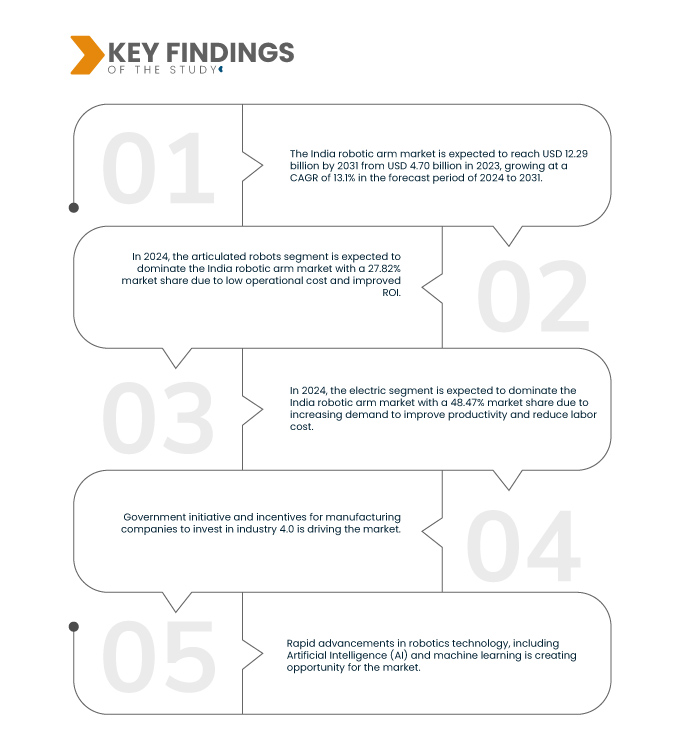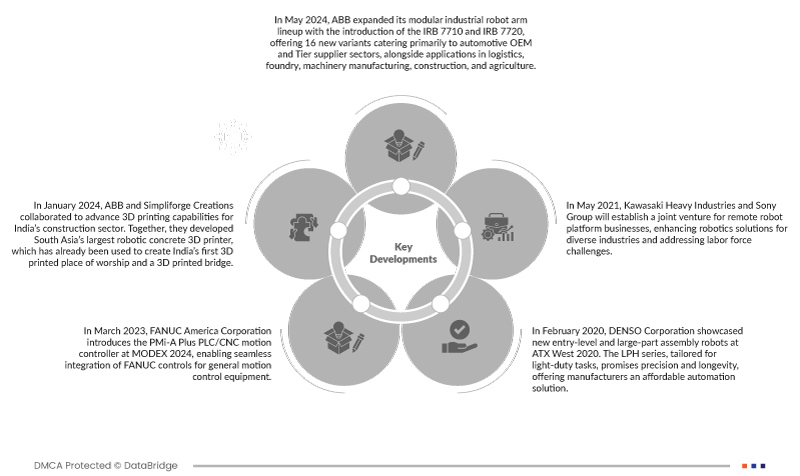The increasing demand for automation across various industries is a key driver for the growth of the robotic arm market. In the manufacturing sector, robotic arms are being widely adopted to improve efficiency and precision in tasks such as assembly, welding, and material handling. These robots enable manufacturers to meet rising consumer demands by enhancing production capacities while ensuring consistent product quality. The capability of robotic arms to execute repetitive tasks with high accuracy minimizes human error and boosts overall operational efficiency, making them essential in contemporary manufacturing settings.
Access Full Report @ https://www.databridgemarketresearch.com/zh/reports/india-robotic-arm-market
Data Bridge Market Research analyses that the India Robotic Arm Market is expected to reach a value of reach USD 12.29 billion by 2031 from USD 4.70 billion in 2023, growing at a CAGR of 13.1% during the forecast period 2024 to 2031. Beyond manufacturing industries such as healthcare, logistics, and agriculture are also integrating robotic arms to streamline their operations. In healthcare, robotic arms assist in surgeries and laboratory processes, enhancing accuracy and alleviating the workload on medical professionals. Logistics companies employ robotic arms for sorting, packing, and palletizing, which improves supply chain efficiency and lowers labor costs. In agriculture, robotic arms facilitate tasks like harvesting and planting, addressing labor shortages and increasing productivity. The adoption of robotic arms across these diverse sectors highlights the expanding trend towards automation, driven by the necessity to enhance efficiency, reduce costs, and maintain competitiveness in an increasingly automated world.
Key Findings of the Study
Government Initiative and Incentives for Manufacturing Companies to Invest in Industry 4.0
The Indian government is actively promoting the adoption of industry 4.0 technologies, including robotics, through various initiatives and incentives. A notable initiative is the Production Linked Incentive (PLI) scheme, which provides subsidies to companies investing in production capacity in sectors such as automotive, metals, pharmaceuticals, and food processing—key users of robotic arms. This scheme aims to enhance the competitiveness of these industries and attract more investment, thereby driving the demand for robotic arms in the market.
Additionally, the government's efforts to improve the ease of doing business and create a conducive environment for manufacturing companies to adopt advanced technologies like robotics is another significant driver. Through policy reforms, infrastructure development, and skill development programs, the government is fostering a supportive ecosystem for the adoption of industry 4.0 technologies, which is expected to further accelerate the demand for robotic arms.
Report Scope and Market Segmentation
|
Report Metric
|
Details
|
|
Forecast Period
|
2024 to 2031
|
|
Base Year
|
2023
|
|
Historic Years
|
2022 (Customizable to 2016-2021)
|
|
Quantitative Units
|
Revenue in USD Billion
|
|
Segments Covered
|
Robot Type (Articulated Robots, Cartesian Robots, Collaborative Robots, SCARA Robots, Parallel Robots, Cylindrical Robots, and Others), Type (Electric, Hydraulic, and Pneumatic), Payload Capacity (100 Kgs-500 Kgs, 500Kgs-1000Kgs, Below 100 Kgs, 1000 Kgs to 3000 Kgs, and Above 3000 Kgs), Axis Type (6 Axis, 7 Axis, 5 Axis, 4 Axis, 3 Axis, 2 Axis, and 1 Axis), Application (Handling, Assembling & Disassembling, Welding & Soldering, Dispensing, Inspection & Quality Testing, Processing, Sorting, Bonding and Sealing, and Others), End Users (Automotive, Electrical & Electronics, Metals & Machinery, Food and Beverages, Plastic and Packaging, Chemicals, Healthcare and Pharmaceuticals, Aerospace and Defense, Logistics and Transportations, Constructions, Oil and Gas, Waste Management and Recycling, Retail, Agriculture, and Others)
|
|
Country Covered
|
India
|
|
Market Players Covered
|
ABB (Switzerland), Kawasaki Heavy Industries (Japan), DENSO CORPORATION (Japan), YASKAWA ELECTRIC CORPORATION (Japan), and FANUC CORPORATION (Japan) Mitsubishi Electric Corporation (Japan), MCI Robotics (India), Seiko Epson Corporation (Japan), Mecademic (Canada), Asimov Robotics (India), Systemantics (India), Svaya Robotics Pvt. Ltd (India), Gridbots Technologies Private Limited. (India), JanyuTech, Universal Robots A/S (India), OMRON Corporation (Japan), and KUKA AG (Germany) among others
|
|
Data Points Covered in the Report
|
In addition to the insights on market scenarios such as market value, growth rate, segmentation, geographical coverage, and major players, the market reports curated by the Data Bridge Market Research also include in-depth expert analysis, geographically represented company-wise production and capacity, network layouts of distributors and partners, detailed and updated price trend analysis and deficit analysis of supply chain and demand.
|
Segment Analysis
The India robotic arm market is categorized into six notable segments based on robot type, type, payload capacity, axis type, application, and end users.
- On the basis of robot type, the India robotic arm market is segmented into articulated robots, cartesian robots, collaborative robots, SCARA robots, parallel robots, cylindrical robots, and others. In 2024, the articulated robots segment is expected to dominate the India robotic arm market with a 27.82% market share
- On the basis of type, the India robotic arm market is segmented into electric, hydraulic, and pneumatic. In 2024, the electric segment is expected to dominate the India robotic arm market with a 48.47% market share
- On the basis of payload capacity, the India robotic arm market is segmented into 100 kgs-500 kgs, 500kgs-1000kgs, 1000 kgs to 3000 kgs, below 100 kgs, and above 3000 Kgs.
In 2024, the 100 kgs-500 kgs segment is expected to dominate the India Robotic Arm Market
In 2024, the 100 kgs-500 kgs segment is expected to dominate the market with the market share of 35.32% due to its optimal balance between payload capacity and versatility.
- On the basis of axis type, the India robotic arm market is segmented into 6 axis, 7 axis, 5 axis, 4 axis, 3 axis, 2 axis, and 1 axis. In 2024, the 6 axis segment is expected to dominate the India robotic arm market with a 29.45% market share
- On the basis of the application, the India robotic arm market is segmented into handling, assembling & disassembling, welding & soldering, dispensing, inspection & quality testing, processing, sorting, bonding and sealing, and others. In 2024, the handling segment is expected to dominate the India robotic arm market with a 23.89% market share.
- On the basis of the end users, the India robotic arm market is segmented into automotive, electrical & electronics, metals and machinery, food and beverages, plastic and packaging, chemicals, healthcare and pharmaceuticals, aerospace and defense, logistics and transportations, constructions, oil and gas, waste management and recycling, retail, agriculture, and others.
In 2024, automotive is expected to dominate the India Robotic Arm Market
In 2024, automotive segment is expected to dominate the market with 25.66% market share due to low operational cost and improved ROI.
Major Players
Data Bridge Market Research analyzes ABB (Switzerland), Kawasaki Heavy Industries, Ltd. (Japan), DENSO CORPORATION (Japan), YASKAWA ELECTRIC CORPORATION (Japan), and FANUC CORPORATION (Japan) as the major players operating in the India robotic arm market.
Market Development
- In May 2024, ABB expanded its modular industrial robot arm lineup with the introduction of the IRB 7710 and IRB 7720, offering 16 new variants catering primarily to automotive OEM and Tier supplier sectors, alongside applications in logistics, foundry, machinery manufacturing, construction, and agriculture. The standardized modular design streamlines installation, enhancing flexibility and cost-effectiveness. With path accuracy down to 0.6mm and payloads of up to 620kg, these robots excel in high-precision tasks, underscoring ABB's commitment to innovation and customer satisfaction
- In January 2024, ABB and Simpliforge Creations collaborated to advance 3D printing capabilities for India’s construction sector. Together, they developed South Asia’s largest robotic concrete 3D printer, which has already been used to create India’s first 3D printed place of worship and a 3D printed bridge. This collaboration aims to revolutionize construction by enabling faster, more sustainable, and safer building methods
- In September 2023, YASKAWA ELECTRIC CORPORATION excelled at WeldfabMeet Pune 2023, showcasing cutting-edge welding automation solutions and emphasizing the importance of quality welding in engineering and fabrication. With their prominent presence and commitment to innovation, Yaskawa India solidified its leadership in the welding automation industry, poised to continue providing top-notch solutions to customers' automation needs
- In February 2022, YASKAWA ELECTRIC CORPORATION opened a new Robotic Solution Facility in Manesar, Gurugram, aiming to enhance industrial robotic automation. The facility showcased cutting-edge technologies for various applications like arc welding, palletizing, and machine tending, fostering closer collaboration with customers. With a state-of-the-art shop floor spanning 45,000 sq. ft., the facility supported manufacturing, assembly, testing, and system integration of customized robotic systems
- In August 2023, FANUC CORPORATION India opened its new Technology Centre in Chennai. The facility reinforces FANUC CORPORATION commitment to serving the nation with state-of-the-art factory automation solutions. The center, equipped with essential infrastructure, aims to provide enhanced services to the rapidly growing industrial hub in Chennai, offering lifetime maintenance support and fostering technology advancement. The eco-friendly design underscores FANUC CORPORATION dedication to sustainability while catering to the needs of the Indian market and promoting Make-in-India initiatives
For more detailed information about India robotic arm market report, click here – https://www.databridgemarketresearch.com/zh/reports/india-robotic-arm-market














